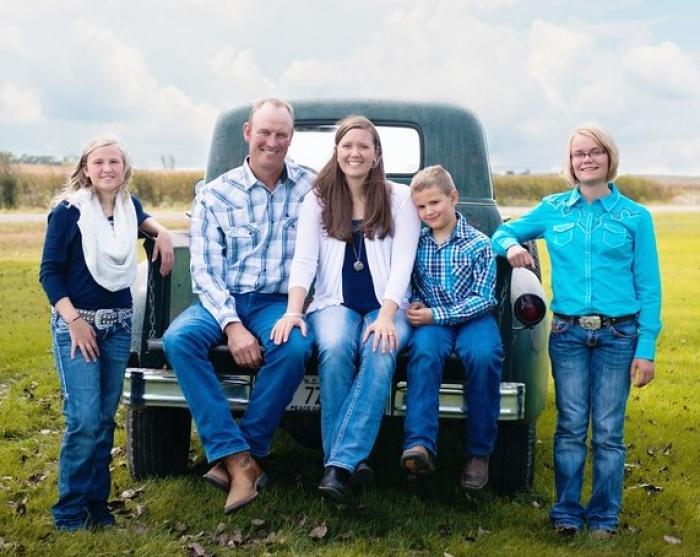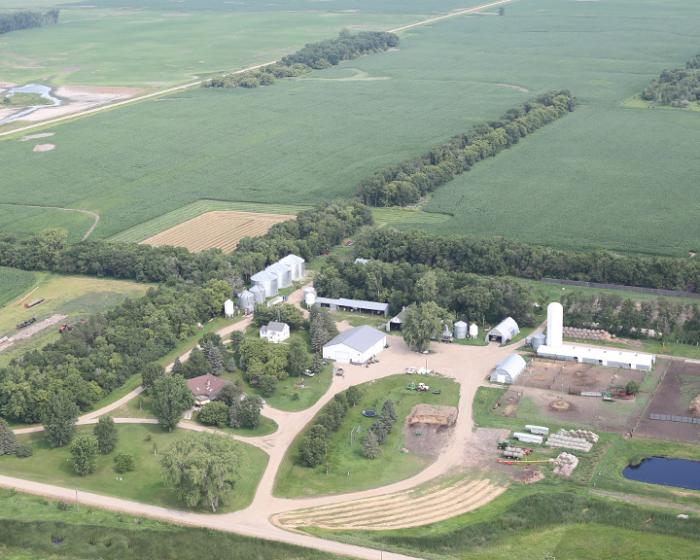Justs Make Strides on Soil Health
While Christof Just has implemented valuable conservation practices through the LaMoure County Natural Resources Conservation Service (NRCS) for the past 15 years, he still continually strives for improved soil health and the resulting better bottom line.
Luann Dart writes from Elgin, N.D.
He and his wife, Kelly, raise corn and soybeans and has a cow/calf operation near Berlin, N.D.
“I really do believe in those five principles of soil health that NRCS talks about,” he says. Those principles include keeping the soil covered with residue (soil armor), minimizing soil disturbance, promoting plant diversity, a having live roots in the soil as long as possible, and integrating livestock into cropland.
The Just have divided their pastures into smaller cells to implement rotational grazing. They used the Environmental Quality Incentives Program (EQIP) to install cross-fencing and place pipeline and tanks in the pasture cells.

Christof rotates cows based on grass condition, but he wants to improve his process.
“I think I’m doing some good or moving in the right direction, but sometimes I look at a cell and I kind of wonder, ‘Should I move them? Should I take this down a little further?’ It is always a work in progress. I’m definitely learning,” he says.
The Justs are enrolled in the Conservation Stewardship Program (CSP), which encourages conservation enhancements. Christof is interested in hiring a grazing consultant who would complete a rangeland inventory and rangeland health assessment and then assist Just with developing a grazing plan.
“I starting to see some benefits and seeing some species starting to show up or becoming more prevalent,” he said. That includes warm season grasses, which have constant pressure without rotational grazing. “They never got a break (before). Some of these pastures probably need to be grazed in May, then rested in June and July. With cell grazing, you can kind of do that. You can give them a rest at different times of the year,” he says.
To extend their grazing season and improve soil health in the fields, Christof has also been planting cover crops for the past 10 years.
He is planting forage barley, cutting it for hay around July 1, then immediately seeds the field with a cover crop mix. The barley bales are placed in a row in the field with electric fencing surrounding them. After the cattle consume the cover crop in late fall or early winter, he then feeds the forage barley right in the fields.
Sorghum-sudangrass is always a main component of his cover crop mix. “You get some nice height and it’s a forage that seems to hold pretty good feed value after a frost into the fall or early winter,” he says.
This year, he planted 130 acres of a cover crop mix that included grazing corn, any leftover corn or soybean seed, turnip, radishes, sunflower, buckwheat, forage collard, common vetch, forage pea, crimson red clover and forage barley.
Having more forage for his cattle is the main benefit of planting the cover crops, but he hopes to see an improvement in his soil, too.
“Hopefully, I’m cycling nutrients and building soil organic matter. With that diverse cover crop mix, there’s a combination of different types of roots and a diversity of leaf shape, so hopefully you’re catching the sun at different angles,” he said. “I’m hoping it pays off in the long run, but a big part of being able to afford to do it is feeding the cattle.”
Just has also flown rye into standing corn in September to produce more forage for grazing or to simply add organic matter to the soil.
“It can work great or it can work not so great,” he said, pointing to one failure. Where he wanted the rye to use moisture in a wet area, the rye flooded out, while it flourished in the dry spots where Just needed to conserve moisture.

“I think that’s why a lot of guys are scared to try some of this. It’s hard to go away from some of this stuff that’s working for them. I don’t blame them,” he said.
Just has implemented variable rate fertilization and uses mostly no-till but sees challenges to that also.
“I’m really trying, but it’s challenging, too. There’s some guys who do tillage around here and their crops look pretty fantastic,” he said.
But he is appreciative of the expertise and assistance from NRCS.
“I really want to believe that we need diversity and that a lot of what we’re doing hasn’t been great for soil health,” he said. “A lot of this ground is becoming unproductive.”
“I really want to be able to infiltrate that rain rather than having it run off into the low spots,” he added. “I don’t want the soil to blow. I want to have a system that’s sustainable or regenerative.”
“Christof and Kelly are great to work with,” said Darin Hirschkorn, District Conservationist with the LaMoure County NRCS office. “They have had multiple contracts with us to help with their conservation goals. Christof is one of the producers that every office wants in the county. He takes a very holistic approach to his farming and ranching and he is always looking for ways to make the resource better. He also talks openly about his failures and successes to everyone that asks to help them with their problems or ideas. If you stick a shovel in his ground and the same soil on a conventional farmer’s ground, you can really see the difference between the two. His soil health is awesome.”

